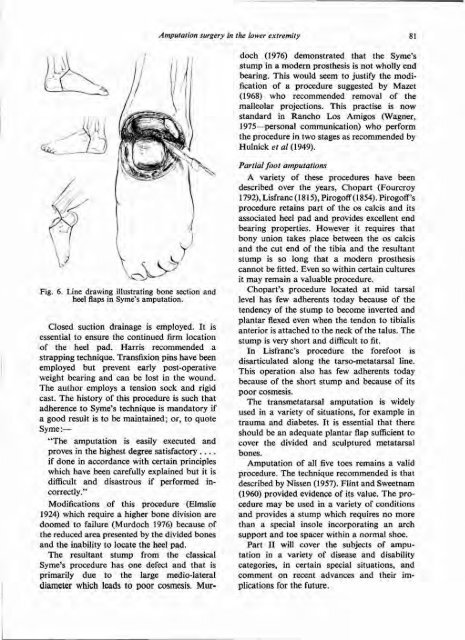Amputation surgery in the lower extremity
Amputation surgery in the lower extremity
Amputation surgery in the lower extremity
Create successful ePaper yourself
Turn your PDF publications into a flip-book with our unique Google optimized e-Paper software.
Modifications of this procedure (Elmslie<br />
1924) which require a higher bone division are<br />
doomed to failure (Murdoch 1976) because of<br />
<strong>the</strong> reduced area presented by <strong>the</strong> divided bones<br />
and <strong>the</strong> <strong>in</strong>ability to locate <strong>the</strong> heel pad.<br />
The resultant stump from <strong>the</strong> classical<br />
Syme's procedure has one defect and that is<br />
primarily due to <strong>the</strong> large medio-lateral<br />
diameter which leads to poor cosmesis. Murdoch<br />
(1976) demonstrated that <strong>the</strong> Syme's<br />
stump <strong>in</strong> a modern pros<strong>the</strong>sis is not wholly end<br />
bear<strong>in</strong>g. This would seem to justify <strong>the</strong> modification<br />
(1968) who recommended removal of <strong>the</strong><br />
malleolar projections. This practise is now<br />
standard <strong>in</strong> Rancho Los Amigos (Wagner,<br />
1975—personal communication) who perform<br />
<strong>the</strong> procedure <strong>in</strong> two stages as recommended by<br />
Hulnick et al (1949).<br />
Fig. 6. L<strong>in</strong>e draw<strong>in</strong>g illustrat<strong>in</strong>g bone section and<br />
heel flaps <strong>in</strong> Syme's amputation.<br />
Closed suction dra<strong>in</strong>age is employed. It is<br />
essential to ensure <strong>the</strong> cont<strong>in</strong>ued firm location<br />
of <strong>the</strong> heel pad. Harris recommended a<br />
strapp<strong>in</strong>g technique. Transfixion p<strong>in</strong>s have been<br />
employed but prevent early post-operative<br />
weight bear<strong>in</strong>g and can be lost <strong>in</strong> <strong>the</strong> wound.<br />
The author employs a tension sock and rigid<br />
cast. The history of this procedure is such that<br />
adherence to Syme's technique is mandatory if<br />
a good result is to be ma<strong>in</strong>ta<strong>in</strong>ed; or, to quote<br />
Syme:—<br />
"The amputation is easily executed and cover <strong>the</strong> divided and sculptured metatarsal<br />
proves <strong>in</strong> <strong>the</strong> highest degree satisfactory ....<br />
if done <strong>in</strong> accordance with certa<strong>in</strong> pr<strong>in</strong>ciples<br />
which have been carefully expla<strong>in</strong>ed but it is<br />
bones.<br />
<strong>Amputation</strong> of all five toes rema<strong>in</strong>s a valid<br />
procedure. The technique recommended is that<br />
difficult and disastrous if performed <strong>in</strong>correctly." described by Nissen (1957). Fl<strong>in</strong>t and Sweetnam<br />
(1960) provided evidence of its value. The procedure<br />
Partial foot<br />
amputations<br />
A variety of <strong>the</strong>se procedures have been<br />
described over <strong>the</strong> years, Chopart (Fourcroy<br />
1792), Lisfranc (1815), Pirogoff (1854). Pirogoff's<br />
procedure reta<strong>in</strong>s part of <strong>the</strong> os calcis and its<br />
associated heel pad and provides excellent end<br />
bear<strong>in</strong>g properties. However it requires that<br />
bony union takes place between <strong>the</strong> os calcis<br />
and <strong>the</strong> cut end of <strong>the</strong> tibia and <strong>the</strong> resultant<br />
stump is so long that a modern pros<strong>the</strong>sis<br />
cannot be fitted. Even so with<strong>in</strong> certa<strong>in</strong> cultures<br />
it may rema<strong>in</strong> a valuable procedure.<br />
Chopart's procedure located at mid tarsal<br />
level has few adherents today because of <strong>the</strong><br />
tendency of <strong>the</strong> stump to become <strong>in</strong>verted and<br />
plantar flexed even when <strong>the</strong> tendon to tibialis<br />
anterior is attached to <strong>the</strong> neck of <strong>the</strong> talus. The<br />
stump is very short and difficult to fit.<br />
In Lisfranc's procedure <strong>the</strong> forefoot is<br />
disarticulated along <strong>the</strong> tarso-metatarsal l<strong>in</strong>e.<br />
This operation also has few adherents today<br />
because of <strong>the</strong> short stump and because of its<br />
poor cosmesis.<br />
The transmetatarsal amputation is widely<br />
used <strong>in</strong> a variety of situations, for example <strong>in</strong><br />
trauma and diabetes. It is essential that <strong>the</strong>re<br />
should be an adequate plantar flap sufficient to<br />
and provides a stump which requires no more<br />
than a special <strong>in</strong>sole <strong>in</strong>corporat<strong>in</strong>g an arch<br />
support and toe spacer with<strong>in</strong> a normal shoe.<br />
Part II will cover <strong>the</strong> subjects of amputation<br />
categories, <strong>in</strong> certa<strong>in</strong> special situations, and<br />
comment on recent advances and <strong>the</strong>ir implications f
















